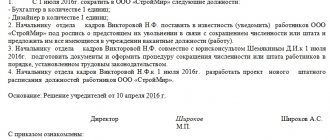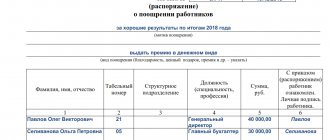List and attendance number of employees
The definition of payroll is clear from the name itself - this is the number of employees registered in the organization. The number on the payroll coincides with the number of employees according to the working time sheet. This includes all employees, including remote workers, seasonal workers, employees on vacation, business trips, absent for health reasons, and temporary employees.
The following categories are not included in the average number:
- Performing work or providing services under GPC agreements.
- Working on an external part-time basis.
Attendance number is the number of personnel actually performing a labor function at the current time. The difference between the payroll and attendance indicators indicates the number of absent employees due to vacations and illnesses.
Calculation of turnout and payroll numbers
The turnout number can be adjusted to the payroll number and vice versa. The list and attendance of workers can be determined by the formula:
- Chsp = Chya x Ksp, Ksp - payroll coefficient is defined as the ratio of the organization's working time to the working time of an individual employee according to the production calendar.
The number of working days of an organization depends on the organization of the work process and work schedule. An enterprise operating in a continuous process environment will have more working days per year than an organization whose employees work from Monday to Friday.
An employee's working time is defined as the planned number of working days minus the vacation period.
The turnout is usually equal to or less than the list. The payroll is determined in the staffing table. The number of personnel is calculated based on production capacity, work process, and administrative resources. Different departments of the organization will have different ratios between payroll and attendance. Administrative staff typically work a five-day schedule. The number of regular and registered employees is approximately the same. But in production shops operating on a shift basis and process continuity, the number of workers who appear will be slightly less than on the list.
Differences between indicators and their application
The differences between the indicators can be determined by their names. As we have already found out, the average is the total number of working persons employed under an agreement with the employer, regardless of their presence at the workplace. It is used in compiling “Information on underemployment and movement of workers.” The Instructions for drawing up the reporting form provide a complete list of the types of workers included in the calculation. But it is also worth considering the fact that it does not include external part-time workers and persons registered under civil law agreements. In addition to this form, enterprises are required to prepare a 4-FSS report, which also displays information about the company’s assets for a certain period of time.
The calculation of the standard is carried out by calculating the number of employed persons, information is taken from the staffing table. Each individual employed under an employment contract is included in the list. composed as one accounting unit. But, if a citizen is registered at the enterprise as an internal part-time worker and occupies more than 1 position, then he is taken into account as part of the list of main employment, that is, also as one unit. If the position is occupied by an external part-time worker, he is not included in the calculation of the indicator. More detailed calculation points are given in the Guidelines for the preparation of statistical reporting.
In comparison, the attendance and list (personnel) number of workers have a different purpose and characteristics. The following value is understood as an indication of the number of individuals from the number of personnel, but actually present at the official place in a certain period of time. This standard is used to calculate production efficiency, the validity of wage costs, and ensuring qualified personnel management. The YaCh standard is indicated in working time sheets using forms T-12 and T-13.
The scope of use of the nuclear value is determined by the Instructions for filling out documents. This:
- determination of working hours;
- monitoring compliance with the production process;
- recording the actual hours worked by each worker;
- collecting information about hours actually worked;
- calculation of the wage fund;
- generation of statistical reports on labor.
The calculation of two indicators is aimed not only at the formation of statistical reporting, but also at monitoring and ensuring the efficiency and availability of the production process with personnel, transport, equipment and other things. Calculation of quantities allows you to determine the need for full staffing, analyze workflow management and eliminate long-term production downtime.
Similar articles
- The number of employees is...
- Number of employees on payroll - formula
- Are external part-time workers included in the payroll?
- Headcount
- Average number of employees
Attendance and payroll number of employees: calculation example
Let's consider a conditional example: the enterprise has 50 machines, 4 people are needed to service one machine. Work is carried out around the clock in 4 shifts. The average annual working time of one employee is 325 days. We will calculate the turnout and payroll numbers.
The minimum number of workers required to ensure the process is the turnout number. The company has 50 machines, which employ 4 people at a time in 4 shifts. Thus: Chya = 50 x 4 x 4 = 800.
The payroll includes all employees who are registered at the enterprise. Using the formula, it will not be difficult to determine the payroll:
- Chsp = Chya x Ksp,
- Ksp = 365 / 325 = 1.123,
- Chsp = 800 x 1.123 = 898.
The payroll will be 898 people, and to ensure continuity of the work process, the attendance of 800 people is required.
This formula determines the need for personnel, taking into account vacations and illnesses of workers. Headcount analysis helps to properly plan personnel management, calculate costs and prevent downtime in the work process.
We determine the standard number of workers (appearance number), storekeepers and tool distributors using the formula [p.59] When calculating the need for workers, you should distinguish between the payroll and the actual number of workers.
The attendance rate determines the number of workers who must go to work in the planning period. List [p.149] Indicators of the number of workers employed in sectors of the economy. Payroll number, turnout number. Methods for calculating the average payroll, average turnout and average number of actually working persons. Indicators of the use of the number of employees at enterprises. [p.444]
The value of the number (appearance) of field repair workers of the PRP, found as a result of the calculation, allows us to determine the payroll number of personnel in the external work shop and, accordingly, other data characteristic of this repair enterprise. [p.358]
A special feature of the headcount standards for gas pipeline transport is that the headcount is determined by the payroll of the enterprise’s employees, i.e. by the average number of not only those working on a given day, but also those who do not come to work due to vacations, illnesses, performance of government duties and others. permitted absences from work. At enterprises transporting oil and petroleum products, including oil supply organizations, staffing standards are drawn up for attendance, which includes workers who are at their workplaces every day. [p.87]
In gas pipeline transport, the headcount standard is drawn up taking into account the transition coefficient from the turnout to the average number, which is defined as the ratio of calendar and average effective working time for one worker [p.87]
When planning, a distinction is made between turnout, payroll and average payroll numbers. Attendance refers to the number of employees who must go to work every day in the planned period. The payroll includes all permanent, temporary and seasonal workers who are hired for more than five days. To determine the payroll number, it is necessary to multiply the turnout number by the so-called transition coefficient. Average headcount is the most frequently used indicator in labor planning. It is determined by dividing the total number of employees on the list for each calendar day (not excluding weekends and holidays) by the corresponding number of calendar days. [p.204]
Transition coefficients from attendance to payroll numbers are determined by dividing the planned annual calendar working time of one worker by his effective working time, calculated taking into account the number of days of absence in accordance with current labor legislation. [p.204]
Determining the coefficient of transition from attendance to payroll is an important point in planning the number of workers. [p.206]
In the technical industrial financial plan, the number is usually calculated in more detail, in groups: workers, main and auxiliary engineering and technical workers, including managers and specialists, employees, junior service personnel, students. The turnout, staffing and payroll numbers are calculated. [p.212]
Turnout number means the maximum permissible number of workers required to perform the appropriate amount of work and fully staff workplaces (service areas) for each structural unit during a work shift. [p.212]
In general, the calculation of the turnout number is made according to the expression [p.212]
The number of workers present can also be calculated on the basis of other types of labor standards, time, service and state standards. [p.213]
The staffing number of workers and engineers working in shifts in discontinuous production is determined by multiplying the number of employees in one shift by the number of shifts, and in continuous production by the staffing coefficient/USSht corresponding to the shift schedule [p.213]
Example. The turnout number of apparatchiks in continuous production with a seven-hour working day is 10 people. per shift. The staffing level will be [p.214]
The methodology for determining the number of workers is different for the main production, its service divisions and auxiliary shops. When planning, the attendance number of workers is determined (per shift, day) and the average number of workers, taking into account substitution on weekends, pre-holidays, during vacations and in connection with other absences permitted by law. [p.196]
The total attendance number of workers per day (Ayav) is calculated by multiplying the attendance number of workers per shift (A) by the number of shifts (ksm) [p.196]
In rationing practice, turnout rates are usually determined. [p.160]
Turnout standards are established using the following methods. [p.162]
Direct standardization of working hours and subsequent determination of the total labor intensity of the annual volume of work, highlighting the labor intensity by type of work. The standard for attendance per shift of number I,,,, to perform one (10, 100 or 1000) work (for example, sampling, laboratory tests, etc.) is determined by the formula [p.162]
STAFF CONVERSION RATIO - an indicator characterizing the share of planned staff absences in the total amount of calendar working days, serves to recalculate the present number of personnel to the list number (and, vice versa), is defined as the ratio of the number of calendar working days to the number of actual working days. (see Working Time Balance). [p.145]
Kp is the coefficient for converting the number of turnout to the payroll. [p.173]
ATTENDANCE NUMBER OF EMPLOYEES - the number of employees, taken into account by the number of days of attendance at work. In contrast to the payroll number of employees in Ya.ch.r. Employees who, while on the company’s lists, did not go to work for various reasons (due to illness, due to a regular vacation, on business trips, etc.) do not appear. [p.449]
When calculating the number of workers, a distinction is made between shift, turnout, regular and payroll personnel. [p.273]
The turnout of workers represents the number of workers servicing production during the day. In continuous production, operating around the clock without stopping on weekends and holidays, staffing is calculated, which is determined as the sum of the attendance and the number of workers to replace weekends according to the shift schedule. [p.273]
The calculation of the number of piece workers employed in machine-manual and manual operations is made based on the planned production volume, the labor intensity of a unit of production and the balance of working time of one worker. First, they determine the labor intensity of the products that they must produce, then they calculate the time fund of one worker, using the working time balance scheme. By dividing the labor intensity of all products by the effective working time of one worker, the required number of workers is determined. The number of workers, calculated according to staffing standards and service standards, represents the turnout number of workers, i.e., the number of workers required to come to work on each given shift to ensure normal production operation. [p.274]
When calculating the number of workers, one should distinguish between turnout REV and payroll RE composition. By turnout (appearance number) we mean the number of workers who must go to work every day in order to ensure the implementation of the production program. The payroll (payroll strength) is the number of workers that, taking into account planned absenteeism and personnel movement (vacations, performance of state and public duties, illness, dismissal, admission) ensures attendance. The relationship between turnout and payroll is expressed through the payroll coefficient ken [p.109]
In current accounting and analytical work at enterprises, it is customary to distinguish between the list and attendance numbers of employees of the enterprise. Listed personnel is the total number of employees of the enterprise registered by order at the moment or on average for the month. The number of staff present is the number of workers who actually went to work on a given day. The difference between the payroll and attendance is made up of workers who are on vacation, on work leave, on business trips, for advanced training, as well as on strikes, absenteeism and who do not show up for work for still unclear reasons. [p.186]
Both the payroll and attendance numbers of personnel are recorded by the enterprise’s statistical service on a daily basis. At the end of the month, their average monthly values are calculated. The ratio of the payroll number of personnel to the turnout is called the payroll ratio. The value of this coefficient is usually about 1.3 - 1.4. This means the following: in order to carry out a production program that requires the daily presence of 1000 workers, the enterprise must have a full-time staff of about 1300 people. The average number of days off for each person will be 21.5 - 23 days off. per month. [p.186]
Planning the number of workers involves determining the required number, most expediently distributing them among production areas, linking the number with the labor productivity plan and creating the necessary ratios in the proportion of different categories of workers. The number of personnel is planned by employee categories. In this case, a distinction is made between turnout and payroll. [p.205]
Based on the deployment staff and staffing points, the turnout of workers is calculated. The number plan must establish the average composition of workers. The latter is equal to the turnout multiplied by the calendar fund of working hours and divided by the effective fund. The fund is determined by constructing a planned budget of working time for the average worker. The budget serves to determine the number of shifts that will be worked by one worker in the planning period. [p.208]
Turnout x calendar working time fund Effective working time fund [p.211]
The turnout includes workers who are at the workplace every day. The list number of workers consists of those who showed up for work on a given day and those who did not show up due to vacation, illness, performance of government duties and other absences from work permitted by law, but included in the list of the enterprise. In other words, the payroll includes all permanent, seasonal and temporary workers for whom the administration has opened work books. [p.274]
To calculate the payroll number of workers for the planning period, it is necessary to multiply their number of workers by the coefficient of lost working time. For continuous production, this coefficient is equal to the ratio of the calendar time fund to the effective working time fund; for continuous production, the ratio of the nominal time fund to the effective working time fund. [p.274]
K,L - coefficient of conversion of attendance to payroll numbers H0 - service rate, i.e. the number of jobs that one person must serve in accordance with the nature of the technological process. [p.276]
Using the number of conditional shifts per day in the calculations, it is possible to calculate the number of workers present for any schedule of going to work. [p.277]
Example. To complete the planned task of drilling wells, a drilling company must have 10 drilling rigs with an electric drive, two drilling rigs with an internal combustion engine (with three engines) and one drilling rig for drilling wells with an electric drill. The coefficient for converting attendance to payroll for workers working in continuous production is 1.3, for daytime workers - 1.12. In this case, the payroll number of drilling workers will be [p.277]
The need for engineering and technical personnel and employees is calculated on the basis of available staff, i.e. for this category of personnel there is no provision for an additional number of workers necessary to replace those on regular leave who did not return to work due to illness or other reasons. The number of junior service personnel is planned based on service standards. Planning the number of students is associated with planning the additional need for workers, which is caused by a loss of personnel due to leaving for the army, for study, retirement, etc. [p.278]
The value of the number (appearance) of CPRP personnel found as a result of the calculation allows us to determine the payroll number of personnel in the external work shop and, accordingly, other data characteristic of this repair enterprise. Similar calculations should be carried out for other considered options for the structure of repair services, differing, for example, in the territorial location of the centralized control center. [p.158]
The number of engineering and technical personnel is planned according to the available staff, i.e. for this category of industrial production personnel there is no provision for an additional number of workers necessary to replace those on regular leave, who do not go to work due to illness or other reasons. The number of fire and security guards is determined in accordance with the number of security and fire protection posts at the enterprise and its subdivisions. [p.206]










